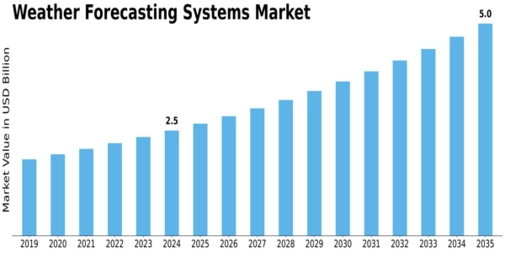Weather Forecasting Systems Market – Advancing Predictive Technologies for a Resilient Future

The increasing unpredictability of climate patterns has made weather forecasting more critical than ever. From aviation and agriculture to energy management and disaster preparedness, accurate weather insights form the foundation of numerous modern industries. The evolution of weather forecasting systems, powered by innovations in satellite imaging, data analytics, and artificial intelligence, is revolutionizing how we anticipate environmental changes and prepare for natural events.
The Weather Forecasting Systems Market has emerged as one of the most vital segments within environmental technology. These systems play an essential role in monitoring atmospheric conditions, predicting storm movements, and supporting emergency planning. With the rising need for early warnings and accurate forecasts, governments and private sectors across the world are investing heavily in modernizing their meteorological infrastructure.
According to comprehensive market analysis, technological innovations are reshaping this domain. The integration of AI, machine learning, and IoT-based sensors has drastically improved precision and speed. As a result, the market’s size, share, and growth continue to expand, reflecting an increasing dependence on digital forecasting solutions to ensure public safety and economic stability.
Enhancing Accuracy with Advanced Forecasting Technologies
Traditional weather prediction relied heavily on historical data and basic radar models. However, modern systems leverage high-resolution satellite imaging, Doppler radar, and supercomputing simulations to produce more accurate short- and long-term forecasts. Artificial intelligence further enhances predictive accuracy by processing massive datasets in real-time and identifying subtle atmospheric trends that human analysts might overlook.
Expanding Applications Across Industries
Weather forecasting systems are not confined to meteorological departments anymore. The energy sector, particularly renewable energy management, relies heavily on precise weather predictions to balance supply and demand. Solar and wind farms adjust their operations based on forecasts that indicate sunlight intensity or wind patterns.
Moreover, logistics and shipping industries utilize advanced forecasting systems to improve navigation safety and reduce risks caused by storms or high tides. With the ongoing digital transformation, industries are incorporating automated weather APIs and sensor networks into their operations to achieve greater resilience and sustainability.
Key Drivers of Market Growth
Several factors are contributing to the strong growth of the weather forecasting systems market. Increasing awareness of climate change impacts and the rise in extreme weather events have made predictive capabilities a necessity rather than a luxury. Governments are prioritizing investments in meteorological infrastructure to ensure timely disaster response and public safety.
Another major driver is the integration of AI-driven analytics platforms. By continuously learning from global climate datasets, these systems refine prediction models and minimize uncertainty in weather outcomes. As innovation continues, the industry analysis suggests that the global market will witness substantial expansion through automation, satellite upgrades, and cross-sector collaboration.
Emerging Trends and Future Outlook
The market is currently witnessing several transformative trends. The adoption of miniaturized sensors, mobile weather stations, and IoT-enabled observation networks is enabling localized forecasting. This granular data provides community-level insights, allowing businesses and governments to make informed decisions faster.
In addition, advancements in radar technologies are enhancing detection accuracy for phenomena such as tornadoes, lightning, and heavy rainfall. Machine learning algorithms are now capable of predicting storm intensity and track with impressive precision. The ongoing collaboration between meteorological institutes and AI research centers further strengthens the innovation ecosystem in this space.
FAQs
Q1: What technologies are driving the weather forecasting systems market?
Technologies such as artificial intelligence, satellite imaging, IoT sensors, and high-speed computing are major drivers. These innovations enhance accuracy, enable real-time updates, and support automated climate modeling.
Q2: Which sectors benefit most from advanced weather forecasting systems?
Key sectors include aviation, agriculture, energy, shipping, and disaster management. Accurate forecasts help these industries plan operations efficiently and minimize weather-related disruptions.
- Art
- Causes
- Crafts
- Dance
- Drinks
- Film
- Fitness
- Food
- Spellen
- Gardening
- Health
- Home
- Literature
- Music
- Networking
- Other
- Party
- Religion
- Shopping
- Sports
- Theater
- Wellness


